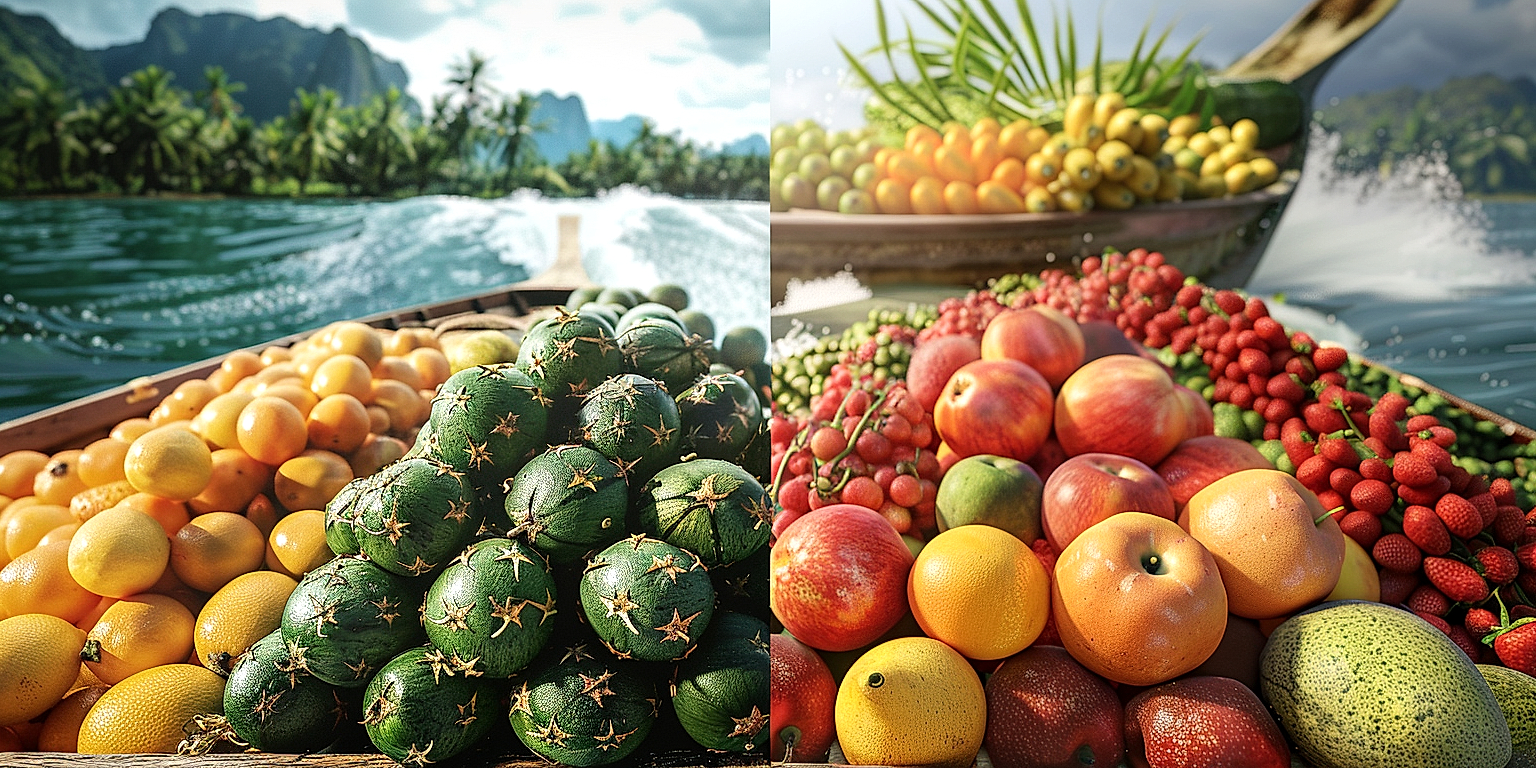In the realm of produce retail, sourcing strategies significantly dictate the quality, cost, and environmental impact of the products we consume daily.
The dichotomy between local and global sourcing approaches presents unique challenges and benefits that shape the industry’s landscape and influence retailers’ decisions.
With the rising consumer awareness of climate change and environmental sustainability, the sourcing approach extends beyond just economic implications.
This article scrutinizes these two principal sourcing strategies, aiming to provide an insightful understanding of their distinct characteristics.
It further explores how each approach affects the produce retail market and the consequences for stakeholders involved.
As we delve deeper into these prosperity drivers in the commerce of fresh produce, we will explore the underlying dynamics worth considering for both retailers and customers.
Local Vs. Global Sourcing Approaches In Produce Retail
1. Local: Direct buying from neighborhood farmers
Direct buying from local farmers is a crucial aspect of local sourcing in produce retail.
It’s a straightforward strategy where retailers purchase ripened fruits and vegetables directly from growers in their immediate communities.
Direct relationships between retailers and local farmers foster increased trust and enable retailers to have a better understanding of the product quality.
When retailers buy directly from local farmers, it encourages transparency, fosters trust, aids in ensuring quality product supply, and bolsters the local economy.
Direct buying ensures freshness and superior quality of produce, which in turn dramatically enhances the customer experience.
Produce from local farms that reaches the retail shelves quickly is likely fresher, tastier, and better looking when compared to products that have undergone long international transportation routes.
From an environmental perspective, local sourcing reduces carbon emissions that otherwise would have been incurred through long-haul transport.
This sourcing method significantly lowers the food mileage, the distance food travels from where it is grown to where it is consumed.
Being local, the goods are less likely to be subjected to heavy chemical preservatives or processing to prolong shelf life, hence, providing healthier food options to customers.
Another advantage of buying directly from local neighborhood farmers is the support businesses provide to sustainable agricultural practices and the local farming community>.
This approach not only strengthens the local economy but also promotes food security.
Often, direct relationships with local farmers allow businesses to obtain exclusive access to certain top-grade products or specialties that might not be available from global suppliers.
However, operational challenges such as fluctuations in seasonal availability, scalability, or required logistics might be a drawback of direct buying from local farmers.
Despite the challenges, many food retailers opt for local sourcing from neighborhood farmers due to its immense benefits that weigh over any disadvantages.
It is undeniable that the model of local sourcing from neighborhood farmers in the produce retail sector not only caters to the demand for fresh, high-quality food products, but also contributes to the sustainability of the local agricultural sector and the strengthening of the local economy.
2. Global: Importing exotic fruits from overseas.
Importing exotic fruits from overseas in a global sourcing approach involves a radically different approach compared to local procurement methods.
Global sourcing revolves around importing produce from different regions of the world.
Specifically, in terms of fruits, it involves sourcing exclusive fruits that are not native to the local environment.
This approach inherently boasts a wide variety in the types of fruits that can be made available to customers at any given time of the year.
The wide variety of choices is possible due to the different seasonal patterns that exist in various global regions.
For example, while it may be winter locally, it could be summer in a country on the other side of the globe, hence offering a supply of fruits that are off-season locally.
The global approach might allow retailers to offer exclusive, exotic fruits such as durians from Southeast Asia or dragon fruit from Central America.
Importing fruits from other countries presents a unique opportunity to provide customers with new tasting experiences and not otherwise found in local food markets.
However, the global sourcing approach requires a sophisticated supply chain process, efficient logistics, and understanding complex international trade laws.
It also demands a deep understanding of the necessary climatic and topographic conditions under which each fruit grows best.
Additionally, fresh produce’s quality assurance becomes a pivotal driving factor in securing trade relationships between countries.
Each country sets its hygiene standards and food safety rules for exported and imported fruits.
In many occasions, fruits are also subject to inspection by the environmental agencies of the importing country.
Despite some challenges, the global approach to sourcing fruits enables consistent availability of a wide array of fruits for consumers and enriches their diets with fruits native to different parts of the world.
This approach could also be an integral part of a retailer’s strategy for differentiating their product offerings and attracting customers with unique tastes.
3. Local: Supporting community through farmers markets.
Embracing local sourcing involves recognizing the value of fostering connections with local farmers and artisans through community markets.
Local farmers markets serve as vital platforms for small-scale growers and producers to sell their goods directly to consumers.
These vibrant bazaars contribute to the local economy, providing farmers with revenue and consumers with fresh, high-quality products.
Adopting local sourcing approaches, like buying from farmers markets, not only strengthens local economies but also helps create more sustainable food systems.
Shopping at farmers markets nurtures relationships between consumers, farmers, and the local community.
It encourages a direct dialogue about origins and methods of cultivation, fostering a deeper understanding and appreciation of food systems.
Buying from farmers markets ensures the money stays within the community, directly empowering local farmers.
Beyond economic benefits, farmers markets also contribute towards environmental sustainability.
Local produce eliminates the need for long-distance transportation, thereby reducing the carbon footprint associated with global sourcing.
This practice ties into the concept of ‘food miles,’ where the environmental impact of transporting food is considered in sourcing decisions.
The seasonal nature of farmers markets also encourages consumers to broaden their palates and try new, seasonal produce.
This approach can lead to a more diversified diet, promoting healthy eating habits.
Moreover, because locally sourced produce is typically grown in smaller quantities, there’s a bigger emphasis on quality over quantity.
This often results in produce that boasts an incredible taste and nutritional profile.
In the context of local sourcing versus global sourcing, it’s clear that supporting community farmers markets offers a multitude of benefits.
However, it doesn’t erase the value of global sourcing, and striking a balance between the two approaches is perhaps the most effective strategy in produce retail.
4. Global: Utilizing International Supply Chains.
Global sourcing in produce retail has paved the way for wider variety and continuous availability of fruits and vegetables.
Thanks to international supply chains, consumers can enjoy summer fruits in the middle of winter and relish the flavor of exotic fruits unique to certain geographical locations.
Due to the different climates and growing seasons across the globe, produce rarely seen in local markets often make their rounds way onto supermarket shelves through global sourcing.
By sourcing from various countries, supermarkets are not only expanding their assortment but also ensuring a steady supply of produce, even during off-season.
Efficient and well-established international supply chains make this global availability possible, overcoming geographical and climatic challenges.
Moreover, global sourcing diversifies risk for retailers. If a crop fails or there’s a supply disruption in one region, retailers can pivot to suppliers in other regions.
From an economic perspective, global sourcing can be more economical for certain types of produce.
Many developing nations can provide certain fruits and vegetables at lower production costs than developed countries, which can translate into cost savings for both retailers and consumers.
Developing such international supplier relationships can promote economic growth in those regions as well, creating a win-win situation.
However, operating within international supply chains also has its set of challenges. These include ensuring quality control across different regions and adhering to varying regulations and standards.
Maintaining the freshness of the produce during long transit times is another significant challenge that requires advanced logistics and specialized infrastructure.
Additionally, ethical considerations come into play, such as fair trade practices and ensuring the welfare of workers in these producing countries.
The environmental impact of transporting produce from distant countries is also a major concern for conscientious consumers.
Regardless of these challenges, the role of global sourcing and international supply chains in produce retail is undeniable and continues to evolve.
With careful planning, risk management, and consideration of ethical and environmental factors, global sourcing can be a viable strategy that complements local sourcing.
5. Local: Seasonal sourcing for fresher produce
As part of a local sourcing strategy, some retailers are pivoting towards seasonal sourcing.
This approach involves buying from local farming operations at times of the year when certain produce items are naturally in their peak season.
Doing this not only supports the local economy, but it also helps to ensure fresher, better-tasting produce for the consumer.
By focusing on seasonal sourcing, retailers can essentially guarantee that produce is at its freshest and most flavorful.
This strategy, however, is not without its challenges.
Many areas have short growing seasons, which can limit the availability of certain types of produce for large portions of the year.
Yet, these limitations, while challenging, can actually work in favor of local sourcing.
As products are only available for a certain period of the year, this can create a sense of urgency among consumers to buy the product.
Moreover, by aligning their sourcing efforts with the growing cycles of local farms, retailers can also help promote sustainable farming practices.
When local farmers are given consistent demand for their produce during the peak season, they are less likely to overplant or resort to harmful practices to accelerate growth.
Thus, the seasonal nature of local sourcing may actually serve as a marketing advantage and a win for sustainability.
Notably, consumers are becoming more and more concerned about the origin and quality of their food.
Seasonal sourcing plays right into this increasing consumer demand for transparency in the food supply chain.
Simply put, local seasonal sourcing gives retailers the opportunity to appeal to consumers’ desire for transparency, sustainability and quality.
The Bottom Line
It is evident that both local and global sourcing of food have their distinct values.
Buying directly from local farmers and supporting community farmers markets not only fosters a sense of community, but also allows for the inclusion of fresher, seasonal produce in our diets.
Meanwhile, the global import of exotic fruits and the utilization of international supply chains broaden our culinary horizons and increase the diversity of nutrients available to us.
So, striking a balance between these two methodologies can allow us to enjoy the best of both worlds, all while promoting sustainable practices and satisfying our diverse palettes.




